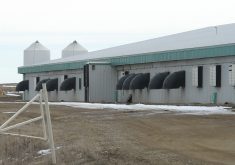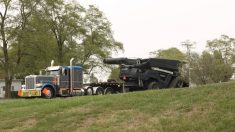St. XAVIER, Mont. – Last fall Tim Nessan seeded at 7.5 m.p.h. with an 80 foot drill in conditions so muddy that other drills were parked.
When his two Deere no-till drills could no longer cope with the mud, Nessan hitched one of his three Big Bud tractors to a new drill of which he had just taken delivery.
He seeded the final 2,800 acres of winter wheat without a glitch using his Australian-built Multiplanter.
It’s the first of this line of drill in North America and Nessan said it’s the ideal machine for wet conditions.
Read Also

Phosphate prices to remain high
Phosphate prices are expected to remain elevated, according to Mosaic’s president.
“It was so muddy last fall that our other drills just couldn’t do the job,” he said.
“But this new seeder pulled easily at 7.5 m.p.h. in the mud. There’s not much of a furrow, so it wasn’t throwing up much dirt. In better conditions, we can do nine. And I’m sure in prime conditions, we can seed at 12 m.p.h. We’ll see.”
Nessan farms 19,000 acres in southern Montana. Each fall, he puts half the land into winter wheat and the other half is chem fallowed.
There are no spring-seeded crops to worry about, but he needs things to go well in the fall.
The entire farm is fenced into large tracts because he custom grazes the 9,500 acres of winter wheat stubble each fall.
However, all that fencing requires a lot of 10-foot wide, grated cattle gates, a hassle when you’re moving big seeding equipment.
He said it was a lucky coincidence that he had already ordered the 80-foot Multiplanter before rain turned his fields to mud last summer.
Nessan ordered the drill from David Trevilyan and daughter, Kris, at a farm show in Montana earlier in the year.
The Trevilyans are the inventors and manufacturers of Multi-Farming implements based in Queensland.
Although Nessan didn’t see the drill until he opened the shipping container, he could tell from the photos and his conversations with the Trevilyans that this was the kind of unit he had been searching for.
In transit, his Multiplanter model is an end-tow, eliminating the folds and hydraulics.
“This seeder is so simple. Very clean and all kinds of clearance. You look at it and you think there’s something missing.”
Nessan has a fertilizer floater and usually puts down 70 pounds of nitrogen in a separate pass. Seed and startup fertilizer go down with the drill. Until the severe mud this fall, he had seeded with 60 and 80foot Deere no-till drills.
“We ran all our seed and startup through the single tube on the Multiplanter, just like we did on the other seeders,” he said.
“This seeder has a second tube if you want to double chute and put down nitrogen. It doesn’t work up much soil, so that narrow packer seemed to work just fine. There’s no offset. It follows the shank exactly.”
The opener can be configured to put nitrogen first, deeper than the seed and fertilizer, or it can be switched so seed and fertilizer go down first with nitrogen following behind.
Each opener is mounted on a parallelogram linkage, independent of the frame, so it follows field contours. Hydraulic pressure on the 18 inch diameter packing wheels is adjusted from the cab.
In Australia, where producers often seed deep to find moisture, some Multiplanter customers put the seed nine inches into the ground and then fill only the bottom of the trench with just a small amount of soil.
Nessan said field efficiency this fall was limited by the size of the air cart. He thinks he needs a cart that can hold 700 bushels or more.
With the right cart, he said, he could seed a section in 12 hours.
“Until now, we’ve always been able to put in 300 acres per day with our 60 foot and about 400 acres per day with the 80 foot.”
Nessan said the low maintenance factor is important when trying to seed so many acres in the fall window. He likes the idea that the only grease points are at the front castor wheels. All other bearings are permanently sealed.
“On the packers, we’re supposed to squirt the seals with WD40 each year before we put it into storage, just to keep them pliable. But that’s about it for maintenance.”
Although the drill looks like a lightweight, Nessan said looks are deceiving because the tubing is all 3/8 inch thick.
“It’s the same tensile strength steel used for truck frames. The parallelograms pivot pins and bushings are from a Caterpillar D9. The shank pivots are off a D3 crawler.
“This thing is made to last. It looks like a lightweight and it pulls so easily because there’s so little resistance, but it is a heavy-duty machine.
“The shanks are so small. That’s why there’s so little draught. Any regular 40 foot seeder I’ve had would pull harder.”
Each tip requires four horsepower in average soil conditions.
Kris Trevilyan said row spacing is another component of low resistance.
“We build the drills with a 13.3 inch row spacing. That’s three rows per metre,” Trevilyan said.
“We’ve found that’s just about the optimal spacing in our conditions. We put the seed exactly where we want, into moist soil and cover it with just enough soil and pack it just enough to get good germination.
“The last thing we want is having the second or third tines (openers) throwing dirt over the first rows, especially when you’re seeding at speed, which we do in Australia.”
She said some of her customers in marginal farming areas increase their row spacing to 20 inches.
Some Australian producers pull two air carts to reduce loading times: one for the left side of the drill and one for the right.
“We have one customer with a 160-foot Multiplanter. That’s two 80 foot seeders running side by side. He uses two Bourgault 5200 air carts, one behind each 80 foot unit.”
The company is building a 220 foot seeder for an Australian customer.
“And we have a design for a 302 foot Multiplanter on the table. It really is just a matter of the farmers with bigger acreages getting their heads around the concept of such a huge machine.
“We use GPS autosteer on the tractor and the Multiplanter so we can do accurate inter row seeding.”
The double drill units use a 40 foot pull pole, which necessitates autosteer on the seeders.
She said the 80 foot Multiplanter that Nessan bought was originally engineered to be one half of a 160 foot drill, but due to hills on his farm, Nessan doesn’t plan to move to the full 160 feet.
For more information, contact Kris Trevilyan at multifs@tpg.com . au.















